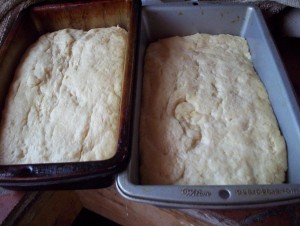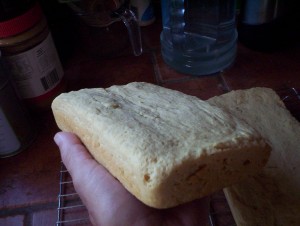I baked again this morning, before it got too hot. Revised the recipe only by adding water and plenty of rising time.
The dough began as before, grainy and brittle and more like plaster of paris than bread dough. But it kneaded quickly into something nice and smooth. The first rise was slow but quite satisfactory, doubling in a little less than an hour.
 The second rise basically didn’t happen. I gave it over an hour and a half and it didn’t happen. This was with every precaution, after proving the yeast, getting a good first rise, keeping it moist in the oven.
The second rise basically didn’t happen. I gave it over an hour and a half and it didn’t happen. This was with every precaution, after proving the yeast, getting a good first rise, keeping it moist in the oven.
Finally I wasn’t going to wait any more, because it was getting hot. (Someday I am going to make a summer kitchen outdoors, I really am.) Decided to waste the propane to see what emerged.
This is what emerged.
 Worse even than yesterday, and yesterday’s was unacceptable.
Worse even than yesterday, and yesterday’s was unacceptable.
This is going straight to the chickens. What am I doing wrong? The only difference between this and my usual bread is the flour. Nothing I read about bread flour prepared me for this problem.
















































I think one thing that might help is using a narrower pan. I’ve had much more luck in the past with all purpose, than with bread flour. But then again, like you, I used all purpose for everything. The bread flour needed fine tuning, and experimentation.
Come to think of it though…the first time I screwed around with all purpose to make bread, the results sucked too. I think you’re just going to have to experiment. Different pans, different moisture content, yeast amount, salt, sugar, etc etc.
Or you can say the hell with it and adopt flatbreads LOL.
I can’t imagine what is going wrong, since it does rise nicely at least once. Try forming your loaves immediately after kneading, and put them into the pans to rise the first time. Forget the second rise. But don’t toss out the flat bred, Joel. I have occasional failures when experimenting with new ingredients myself. I slice them thin and let them dry out completely. They make wonderful dog treats.
Ghost isn’t wild about bread, ML, though of course LB will cheerfully eat it. The chickens, on the other hand, riot over stale bread.
Keep experimenting. The worst possible result is ecstatically happy chickens. (OK, perhaps also an empty propane tank) Unless there is truly something wrong with the flour, the solution is out there waiting for you to find it.
Oh yeah, I’d forgotten about the chickens. Good deal. 🙂 Eggs are $3.25 a dozen here now for “large.” Won’t last long, but I’m in serious envy of those who can keep chickens right now. 🙂
Joel, What *kind* of bread flour is it ? Brand, I mean. This is pretty odd behavior. I would expect a difference, but not *that* much of a difference.
and….I know that at one point, you posted your bread recipe…could you link to it so I can see what you are working with?
http://joelsgulch.com/making-bread-easy/
The new bread flour is from Con Agra.
Couple of thoughts and things from a book on no knead breads:
Yeast becomes less effective at temps over 95 degrees. 85-95 are ideal rise temps.
Bread flour is higher in protein and gluten than AP so it should take more water to activate than AP.
The book is recommending about a ½ cup more water for a recipe using 6-½ cups of flour if you’re using bread flour in place of AP.
The recipes are for no knead doughs so they are wetter doughs than normal breads but I’m guessing the same principles apply. Hope the info helps.
It might be the brand of flour. I checked several places, and found that quite a few people discovered significant differences between their regular bread flour and the con agra brand.
your bread recipe looks fine, the proportions are good…in fact the yeast should be REAL happy with the sugar.
Perhaps try an experiment….try some King Arthur bread flour (the unbleached stuff)…I can send you some. I’ll have to root around for your address. See if you get sorta normal results with *normal* bread flour.
The address will have changed, Unreconstructed. Don’t send without emailing for new mail drop addy.
Joel with your results I’d suggest you try making bread dough using a biga AKA a sponge or starter and dough autolysis. You can turn that into sourdough, but it’s usually used for regular bread. It’s a lot easier overall than your normal method and you can start the process before you go to bed, then get up and finish your bread in the cool morning. Starting the process just means tossing a few things in a bowl, stirring, covering the bowl, and going to bed. The biga/autolyse process will hydrate the flour completely and also release sugars. There are lots of recipes on the Internet for this process. Pick a very simple one to start. I use King Arthur flour, have never had a problem even when I get really sloppy about my recipe. It isn’t the cheapest where I live, but it produces consistent good results. Other people swear by Gold Medal. I’ve never used ConAgra.
We have been using Conagra bread flour from costco right along. My recipe is a pint of water, a couple T spoons of sugar, a table spoon of yeast, half a cup of powdered milk, two eggs and 2 cups flour. When it shows the yeast is proofed I add about three more cups, nead, rise etc. My bread is decent. My wife uses the same flour and yeast sugar, eggs but adds oil and mixes it all at once with the kitchen aid dough hook. He bread comes out 20 to30% taller in the same pans. Go figure.
Howard
Joel, I grew up in a bakery and bake my bread still. I’ve baked many kinds, 100 loaves at a time, now 4 at a time for the week. I’ve never seen that much oil (fat) used in proportion to the rest of ingredients. 2 tablespoons of fat per 3 to 31/2 cups dry ingred. should solve your problem
Great advice, Glenn! I didn’t remember that he used so much fat. No wonder it won’t rise again. All the molecules are slipping down to the bottom of the pan. 🙂
Interesting, Glenn555! Thanks, I’ll try that next time. Today I already baked bread with the usual all-purpose flour, or I’d try it today.
Any chance you are your flour change has coincided with the viability of your aging yeast dropping off the wrong side of the bell curve?
No, the yeast is fairly new. And I prove it on every batch. Anyway I made bread this morning with my usual flour, and it rose just fine.
If your yeast is only doing one rise, maybe adding a little more sugar to feed it might help. The yeast converts sugars to CO2, so maybe your current flour has less sugars available for the yeast and it needs more sugar to provide the second rise.
Kwitcher bitchin. Some people actually CELEBRATE by eating bread risen significantly less than that:
http://tinyurl.com/ohfkymt
}:-]
Of course, maybe you’re just not using the right ingredients:
http://mausersandmuffins.blogspot.com/2015/06/have-can-of-beer-you-can-bake-bread.html
}:-]
As she says, you do have to figger out what to do with the OTHER five cans…